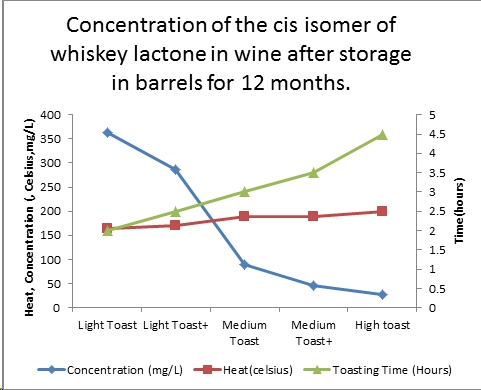Oak lactones are key to the aroma imparted by oak barrels. The aroma of bourbon whiskey is dominated by oak lactones and vanillin. Sean Eridon, 2015
Use of oak is the only method of flavor addition to wine allowed, and can be controlled through many different parameters making it an invaluable tool for a skilled and experienced winemaker. Compounds of note which are imparted by Oak include ellagitanins, phenolic aldehydes such as vanillin, volatile phenols such as eugenol, and lactones (Chira et al, 2013). The major contributor to extractable oak volatile compounds is beta-methyl-gamma-octalactones, which is found as both cis and trans isomers, their presence in oak as well as spirits has led to the colloquial terms of oak or whiskey lactones. Analysis of these compounds is generally achieved through Gas Chromatography, though analysis of precursors has been achieved through HPLC (Hayasaka et al. 2007). The Cis isomer is the more prevalent form found in wine and has a lower sensory threshold of 0.074mg/L in red wine compared to 0.32 mg/L for the trans isomer(Abbot et al, 1995). The two isomers have similar but different aromas associated with them, both being characterized by coconut aroma when pure. Other volatile aroma compounds can modify the impact of is b-methyl-g-octalactones. In wine they have been described as smelling of vanilla and caramel, as well as woody, spicy, and sweet (Reazin et al, 1981)(Chira et al, 2013).

Figure 1: Cis and trans isomers of beta-methyl-gamma-octalactone (Left and Right respectively). (Copied from wikipedia under the GNU Free Documentation License)
Differences in oak and enological procedures can change the concentration of oak lactones in a wine. The species of oak used, generally either Quercus Alba or Quercus petrea, has a large impact on the concentrations of the two isomers. Chira et al (2015) found that wines aged in barrels made from Q.Alba had higher concentrations of oak lactones than those aged n barrels made from Q. Petrea. The tree species also influences the ratio of cis:trans isomers found in the wine, and can be used to identify the species of oak used (Waterhouse et al, 1994). Other aspects can also influence the concentration of oak lactones in different sources of wood such as geographic location(alanon 2011), coopering, and barrel history. As barrels age and are used multiple times, the concentration of oak lactones imparted to wines decreases (Towey et al, 1996). Barrels are made using different amount of heat for different lengths of time leading to different "toasting" designations. As toasting time and heat increases, the amount of oak lactones imparted to a wine decrease as seen in figure 2 (Chira et al, 2013). The extraction kinetics of oak lactones from barrels can be modified by a wines composition. Notably, hydronium, titratable acid, and alcohol concentrations are negatively correlated with oak lactone concentrations, which could be explained by formation of the acid or ester form of the compounds, rather than lactones (Rodriguez-Rodriguez et al, 2012).

Figure 2: The effect of increased toasting on the concentration of the cis isomer of whiskey lactone in wine after storage in barrels for 12 months. Data from Chira et al. 2013.
References
Abbott, N. Puech, J.-L. 1995. Determination of the Aroma Threshold of the cis and trans Racemic Forms of β-Methyl-γ-Octalactone by Gas Chromatography-Sniffing Analysis. Am. J. Enol. Vitic. 46:292-294.
Alanon, E. M. et al. 2011. Influence of geographical location, site and silvicultural parameters, on volatile composition of Quercus pyrenaica Willd. Wood used in wine aging. Forest Ecol and Man. 262:124-130.
Chira, K. Teissedre, P-L.2015. Chemical and sensory evaluation of wine matured in oak barrel: effect of oak species involved and toasting process. Eur Food Res Tech. 240:533-547.
Chira, K. Teissedre, P.-L. 2013. Extraction of oak volatiles and ellagitannins compounds and sensory profile of wine aged with French winewoods subjected to different toasting methods: Behavior during storage. Food Chem. 104:168-177.
Hayasaka, Y., et al. 2007 Identification of Natural Oak Lactone Precursors in Extracts of American and French Oak Woods by Liquid Chromatography–Tandem Mass Spectrometry. J. Agric. Food Chem. 55:9195-9201.
Reazin, G.H. 1981. Chemical Mechanisms of Whiskey Maturation. Am. J. Enol. Vitic. 4:283-289.
Rodriguez-Rodriguez, P. Gomez-Plaza, Encarna. 2012. Dependence of Oak-Related Volatile Compounds on the Physicochemical Characteristics of Barrel-Aged Wines. Food Tech Biotech. 50:59-65.
Towey, J.P., Waterhouse, A.L. 1996. The Extraction of Volatile Compounds From French and American Oak Barrels in Chardonnay During Three Successive Vintages. Am. J. Enol. Vitic. 2:163-172.
Waterhouse, A. L. Towey, J. P. 1994. Oak Lactone Isomer Ratio Distinguishes between Wines Fermented in American and French Oak Barrels. J. Agric. Food Chem. 42:1971-1974.
